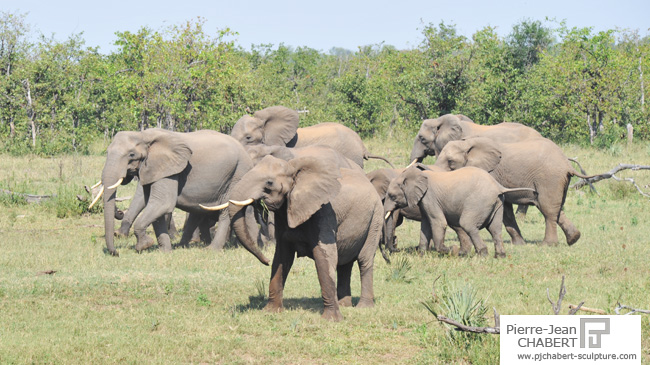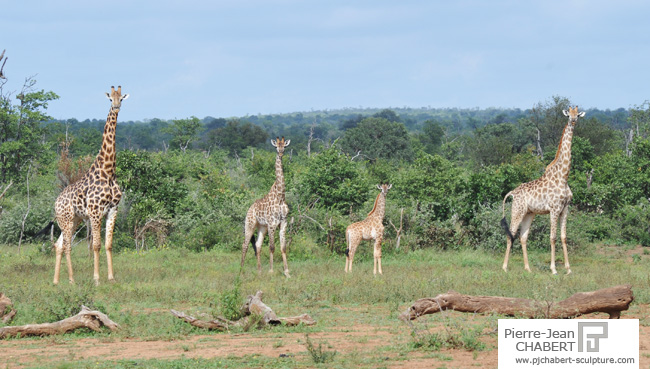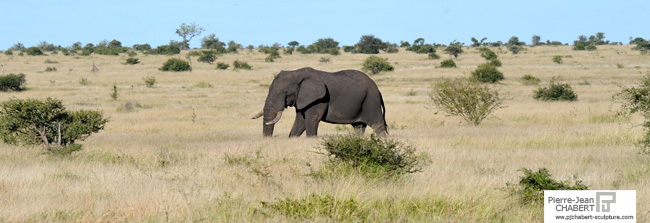STORY OF AFRICA
October 2013
October 2013
SOUTH AFRICA

After a 6 hour drive from Johannesburg, we arrive at the Letaba Reserve near Phalaborwa.
The landscape is constantly changing: between shrubs, plains of yellowed grass and tall trees, hydrated by the streams. The earth, for its part, changes from red, to brown and grey. The large, colourful termite mounds are worthy representatives of this.
Standing at the back of the pick-ups lifting the red dust from the track, we see herds of impalas (antelopes) leaping through the shrubby savannah.
It's the rutting season, the males are fighting each other dry and the guttural sound they make reminds me of a beer drinker who can't hold back gas escapes and ends with the whistle of a smoker.
Some groups run away, others surprised but suspicious, observe us.

Wildebeest are not numerous in this region but luck allows us to see a blue wildebeest, a solitary male wandering around its territory.
As we approach, a small jackal moves away, scanning us.
We surprise a great kudu (great antelope) and its females, grazing peacefully and then disappearing majestically between the bushes in a few leaps.

From the top of a topi (hill) we see large herds of buffalo moving around. With binoculars, we can also see some groups of elephants walking at a good pace.

Coming down from the topi, a big, old, solitary, lonely, "monopointe" (single tusk) elephant is facing us. It is moving towards us. We look so small in our 4×4s.
John, our ranger, arms his machine gun to fire into the air if the pachyderm tries to charge.
The mastodon doesn't seem intimidated, he continues towards us and we back up, he is at home, he has the right of way... then he enters the shrubby savannah and slowly disappears.

The long strikes of the giraffes straighten up and look at us before fleeing as if in slow motion, in that gallop that is so characteristic of them. The giraffes follow closely.

The days follow one another, and the encounters accumulate.
At one point, about thirty metres away from us, it is a solitary great buffalo that smells the air in our direction, orienting its big ears at the slightest sound.
Later, it is a female elephant that tries to intimidate us by barring its way. With her head raised and her ears spread apart, she hesitates to charge.
The zebras rush into the thickets, disturbed in their recurring fights and hoofbeats.

A snake, also called a secretary (a kind of bird of prey), frolics on its large legs in search of a snake or a few field mice. It is curiously more at ease on the ground than in the air and seems to make only short aerial trips to get away.
Blue-bellied rabbits court each other and frolic in the air. The little kalaos with their long beaks amuse me a lot. Their flight reminds me of a long breaststroke.
The sun sets and radiates warm orange tones in the sky.
![]()
We take advantage of this moment to drink a beer, and we drink a toast to the health of the few elephants that pass a hundred meters away.

In the morning, it is a swirling column of about thirty vultures that we decide to follow. The aim, to check that the animal they covet has not been a victim of poaching. But this is not easy. Seeing men arriving, they move so as not to reveal the object of their quest, but our African guides are gifted. But our African guides are good. They find after about ten minutes of walking, an impala that has died after an opponent's horn was blown. The antelope has already been well started by the birds of prey.

At hot hours, the animals remain "tanked up". They avoid steps and rest. We take the opportunity to have a barbecue in the middle of the savannah, near a water point. South African beef and cheddar and garlic bread. A change of scenery.
After three or four days, especially at the end of the day, by dint of looking for animals, I am taken by some visual hallucinations. I start to see animals anywhere: instead of a shrub or a piece of rock... We talk about it with the people who accompany me. I am reassured, I am not the only one, even if it remains a curious sensation.
Small engoulevents (nocturnal birds) appear at nightfall (around 6pm). Some hornbills hover in front of the car. Once again we witness a magnificent sunset. We are heading towards the exit of the reserve, raising a large trail of dust that accumulates on our faces and clothes.

The freshness of the African night is felt. The parkas are very useful to us.

Today is a first day with the insects. They are very present. The rains of the previous weeks have done their job. And the strong heat of these few days has undoubtedly helped them to hatch.
But the animals remain discreet, perhaps hidden in some forests or korongos (dry river beds). It is frustrating!
The day goes on and luck shows its nose.
A bath of elephants in a lake fills us with wonder. The youngest ones throw water jeysers at each other and the older ones refresh themselves. Two or three others stay on the bank, under the trees, quietly ruminating, but with their senses alert.

Then later, John, the ranger from the reserve, makes our car stop and gives us a funny sign! A kind of arm-wrestling. Everybody looks at each other and nobody understands...He stretches out his arm...And there, hidden in the thickets a hundred and fifty metres away, we see a small family of white rhinoceros. Both parents and two "teenagers", our ranger doing his "arm of honour" mimicked the rhino's horn.
Moved by this vision, we get off the 4×4s and try to approach them. Their big ears are on the lookout, swivelling in all directions while their noses are looking for the smells carried by the wind. The group separates. We approach a hundred metres away. They are staring at us even though their eyesight is very bad. Then they faint between the bushes, with a light trot.
What a spectacle! What luck!

We cross the road of a group of elephants who have just been drinking in a pond. An angry female elephant faces us. The rest of the herd moves away in a cloud of dust.
The female spreads her ears and barricades her way strongly. She happens to have a malformed tusk that pushes in the other direction, which must be constantly bothering her. This would explain her aggressive behaviour. She approaches about ten metres from the vehicle. Not really reassuring. Then she runs away to rejoin her fellow drivers.

From the top of a hill, a herd of buffaloes of 120 to 150 head moves regularly, grazing. At nearly a ton per animal, this weighs heavily on the scales.
Some males try to mate with females who continue their march as if nothing had happened.

We don't meet any fawns except a beautiful leopard at nightfall.
Marabouts (scavenging birds) make their appearance. One of them glides quietly with its huge wings, landing from tree to tree.

A few zebras, a family of vervets (monkeys), galloping giraffes, a great kudu and its females, impalas in a mess, hippotragues, crescent cobes, ostriches with their heads in the sand, a group of elephants who, disturbed by buffaloes, start to chase them, hippos lazing in the sun... In short, Africa remains a formidable animal wealth.
Nine extraordinary days that I will keep anchored deep inside myself.




